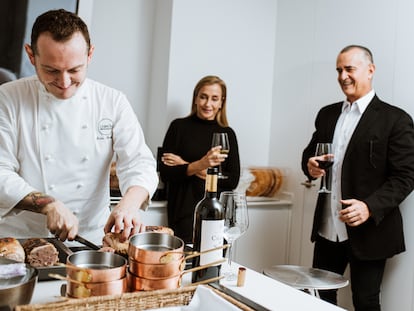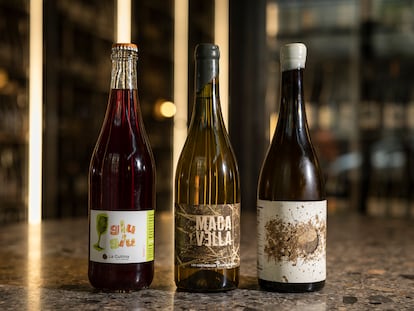Horse meat: a history of food prejudice
Europe is divided between horse meat lovers such as Germany, where there are specialized butcher shops called ‘pferdemetzgereien,’ and countries that reject it outright, like the United Kingdom
Our food choices are neither free nor arbitrary. Traditionally, each town has resolved its nutritional needs by adapting to the resources of the ecosystem it inhabits. But food is not just a physiological issue: it is a complex system of sociocultural beliefs that conditions what we put on the table. Therefore, to understand the low consumption of horse meat in some countries, we have to delve into this cultural imaginary forged over the centuries.
In the Paleolithic, men chased wild herds of horses. They were hunted and represented pictorially, but their domestication was complicated due to the animal’s own character and the enormous expense involved in feeding it (a horse eats 30% more grass than a ruminant). Strong, noble and energetic, horses were therefore relegated to agricultural tasks by the first and populous civilizations of Asia and the Middle East. The horse and the plow formed a perfect symbiosis. Raising a couple of horses as a draft animal made sense, but raising large numbers did not. Except in the Asian steppes, endless grassy plains where nomadic shepherds like the Scythians survived on mare meat and milk. The Greek historian Herodotus, in the 5th century BC, recounts the way of life of this “barbarian” (foreign) people that the classical world considered uncivilized due to their detachment from agriculture, the basis of the diet of Classical Greece and Rome. Their contempt, writes Massimo Montanari in his book The Culture of Food, was also based on the fact that they practiced ritual cannibalism. However, both the Greeks and the Romans began to import horses from their nomadic neighbors and adapted them to their own needs. In the last years of the Roman Empire it was said that the Mongols survived long journeys by sucking the blood of their horses and that the Huns learned to ride before they could walk, so there was a real fear of the hordes that lurked along Rome’s border with the Danube. In no Roman banquet, where one could taste anything from flamingo to bear meat, was there ever a horse dish.

For the Hebrew people, the horse, a non-ruminant animal with uncloven hooves, was impure and not suitable for human consumption according to kosher food standards. For the Muslims who crossed all of Asia Minor to reach the future Al-Andalus, in Spain, on the backs of light and agile horses, the fatty meat of a lamb or a goat was preferable to that of such a useful and appreciated animal. Marvin Harris, the American anthropologist, creator of cultural materialism and author of Good to Eat: Riddles of Food and Culture, wrote that empires rose and fell literally on the backs of horses: horses bred for their speed, nerve and firmness in the heat of battle, not for the meat and milk they could provide. And so, he explains, a long network of taboos was woven around this animal that was resistant to domestication and difficult to milk, despite the fact that its milk is very sugary and has great nutritional properties.
However, much more pragmatic reasons underlie this rejection of horses as food. Harris explains that the taboos that linked the horse to pagan and nomadic peoples persisted beyond the ancient civilizations based on the cultivation of cereals and experienced their peak during the early Middle Ages, a time when Christianity was defending itself against Islam thanks to a war machine consisting of knights with heavy armor sitting on the back of strong and robust horses. The very basis of feudalism is “a military contract for the provision of heavy cavalry.”
Today, Europe is divided between hippophagi, or lovers of horse meat, such as Germany, where there are establishments dedicated solely to it, the so-called pferdemetzgereien, as well as Poland, France and Italy to a lesser extent, and those that reject it outright, like the United Kingdom. In Spain its consumption is residual, and occurs mainly in the northern regions of Navarre, Castilla y León and Catalonia. In the latter, the breeding, sale and distribution of the Cavall Català del Pirineu breed has been promoted since 2007 through an agreement between the regional government and the University of Barcelona that defines the characteristics of this mountain breed that extends through the areas of La Cerdanya, El Ripollés, Alta Ribagorça, Pallars, Alt Urgell and Vall d’Aràn. A breeders’ association called Associació de criadors d’eugues de muntanya del Pirineu, for its part, tries to promote the consumption of organic horse meat, which contains much less cholesterol than beef and more Omega3. The association also works to protect and expand horse culture in Catalonia with traditional events such as the Fira del cavall de Puigcerdà, in Cerdanya, and the Tria de mulats d’Espinavell, in Ripollés.

Every October, els escamots d’eugues (groups of mares and stallions) come down from the mountain where they have remained during the summer months and the best specimens are selected. Marisa Buxeda, a breeder of Cavall del Pirineu in the town of Molló, in Girona province, explains that the use of these communal lands where her animals and others graze dates back to ancient times. She explains about the work of l’eugasser, the shepherd who stayed all summer with l’escamot up in the mountains, but, above all, about her passion for this animal that she defines as the perfect mirror: “A horse, when it looks at you, knows what you are feeling. The bond is very special.”
Sign up for our weekly newsletter to get more English-language news coverage from EL PAÍS USA Edition
Tu suscripción se está usando en otro dispositivo
¿Quieres añadir otro usuario a tu suscripción?
Si continúas leyendo en este dispositivo, no se podrá leer en el otro.
FlechaTu suscripción se está usando en otro dispositivo y solo puedes acceder a EL PAÍS desde un dispositivo a la vez.
Si quieres compartir tu cuenta, cambia tu suscripción a la modalidad Premium, así podrás añadir otro usuario. Cada uno accederá con su propia cuenta de email, lo que os permitirá personalizar vuestra experiencia en EL PAÍS.
¿Tienes una suscripción de empresa? Accede aquí para contratar más cuentas.
En el caso de no saber quién está usando tu cuenta, te recomendamos cambiar tu contraseña aquí.
Si decides continuar compartiendo tu cuenta, este mensaje se mostrará en tu dispositivo y en el de la otra persona que está usando tu cuenta de forma indefinida, afectando a tu experiencia de lectura. Puedes consultar aquí los términos y condiciones de la suscripción digital.
More information

A day in the life of a private chef: A trend that is sweeping social media
Archived In
Últimas noticias
Aquilino Gonell, former Capitol sergeant: ‘If it hadn’t been for the police, the US would be a dictatorship’
A hybrid building: Soccer pitch, housing, and a shopping mall
Europe urges Trump to respect Greenland following annexation threats
Science seeks keys to human longevity in the genetic mixing of Brazilian supercentenarians
Most viewed
- Alain Aspect, Nobel laureate in physics: ‘Einstein was so smart that he would have had to recognize quantum entanglement’
- Mexico’s missing people crisis casts a shadow over World Cup venue
- Alvin Hellerstein, a 92-year-old judge appointed by Bill Clinton, to preside over Maduro’s trial in New York
- Why oil has been at the center of Venezuela-US conflicts for decades
- Cuba confirms death of 32 of its citizens in the US attack against Venezuela









































